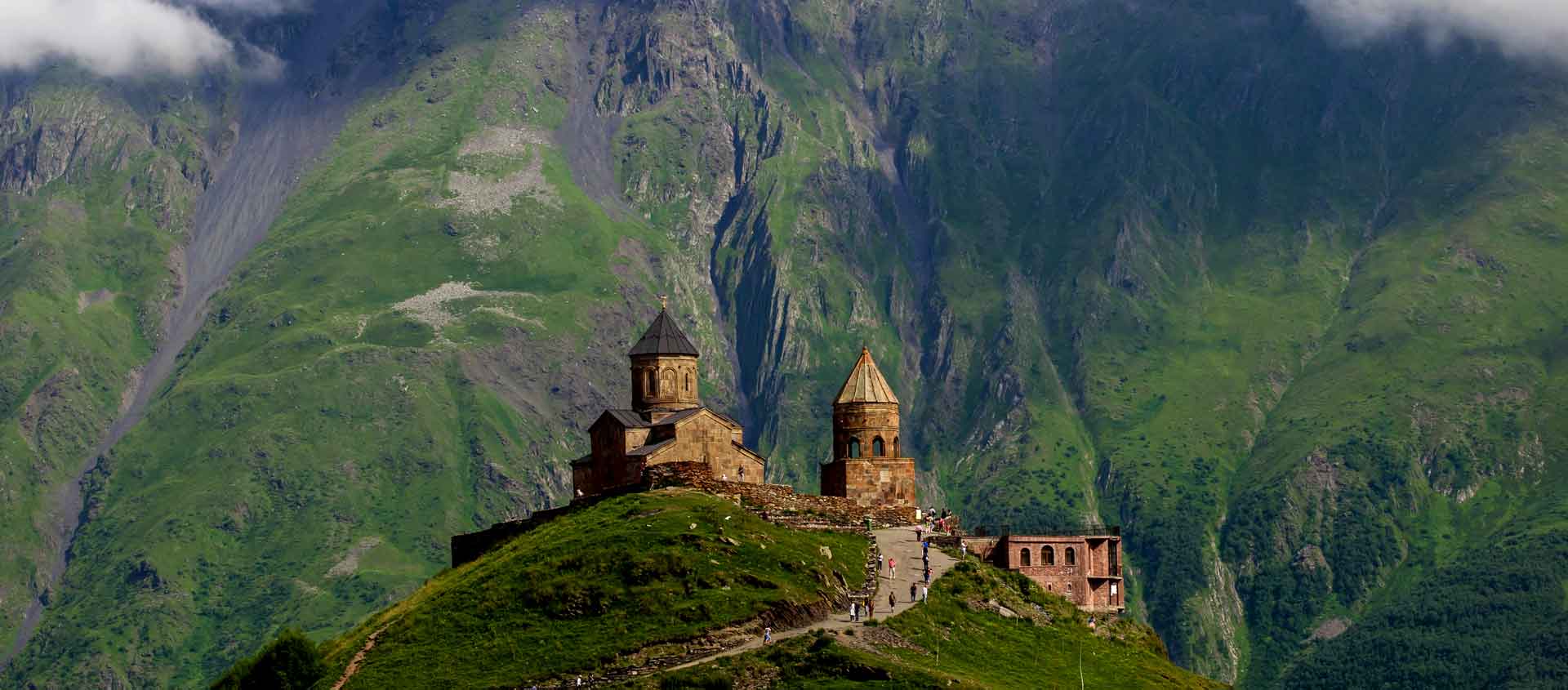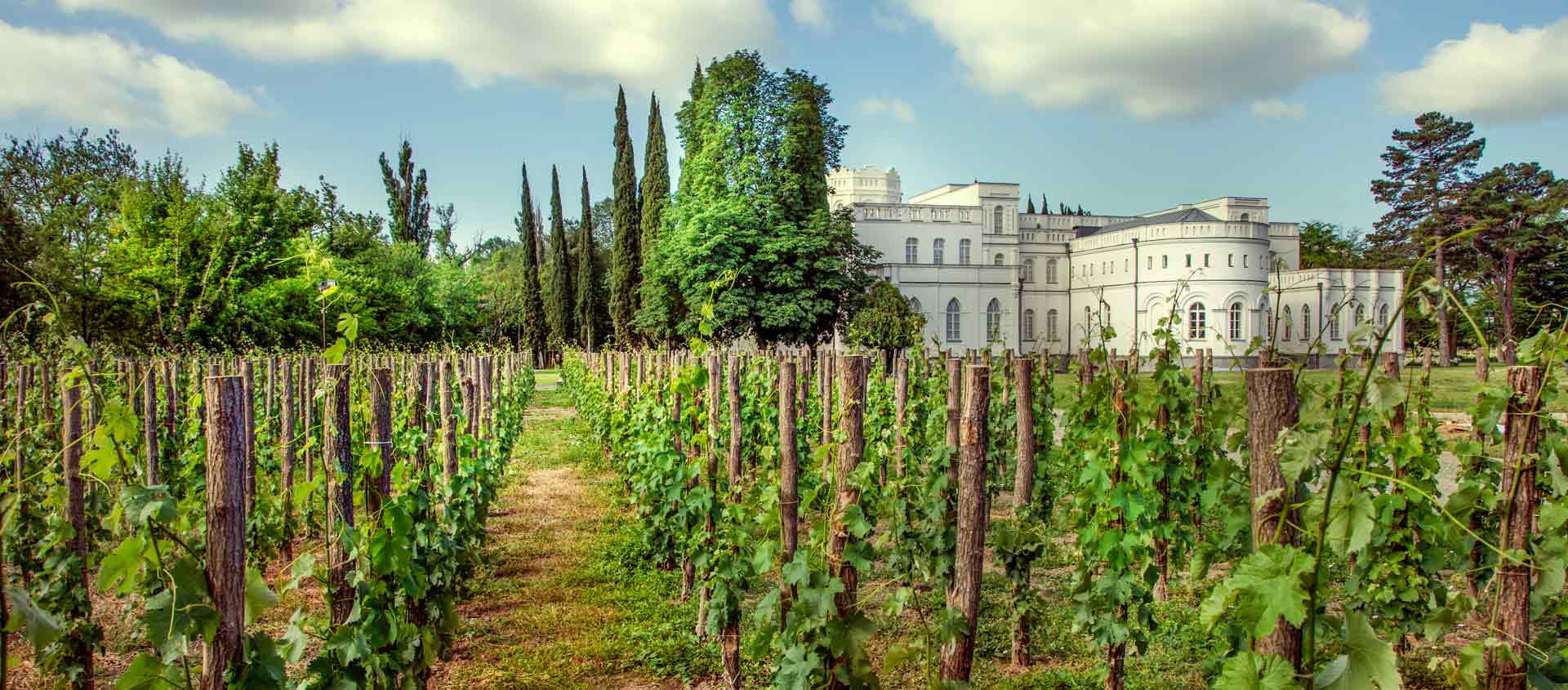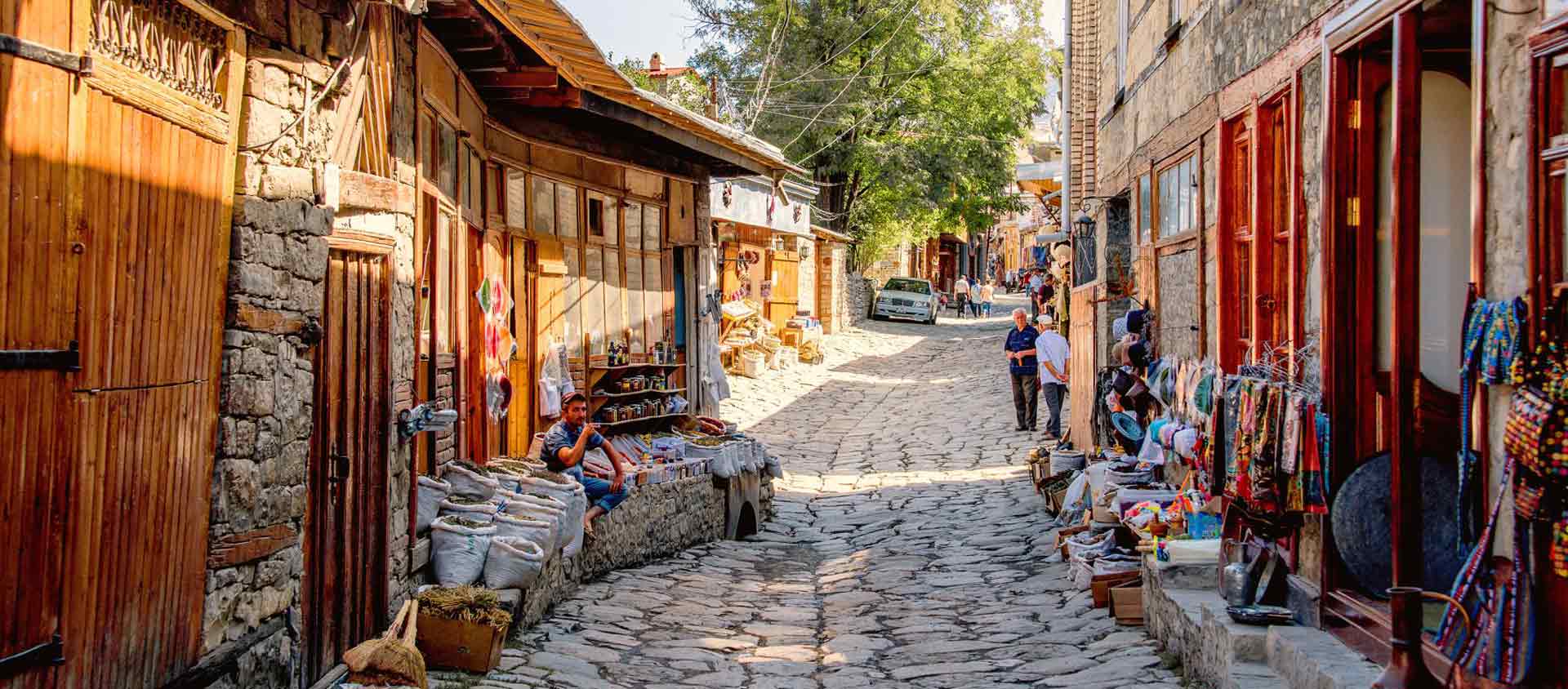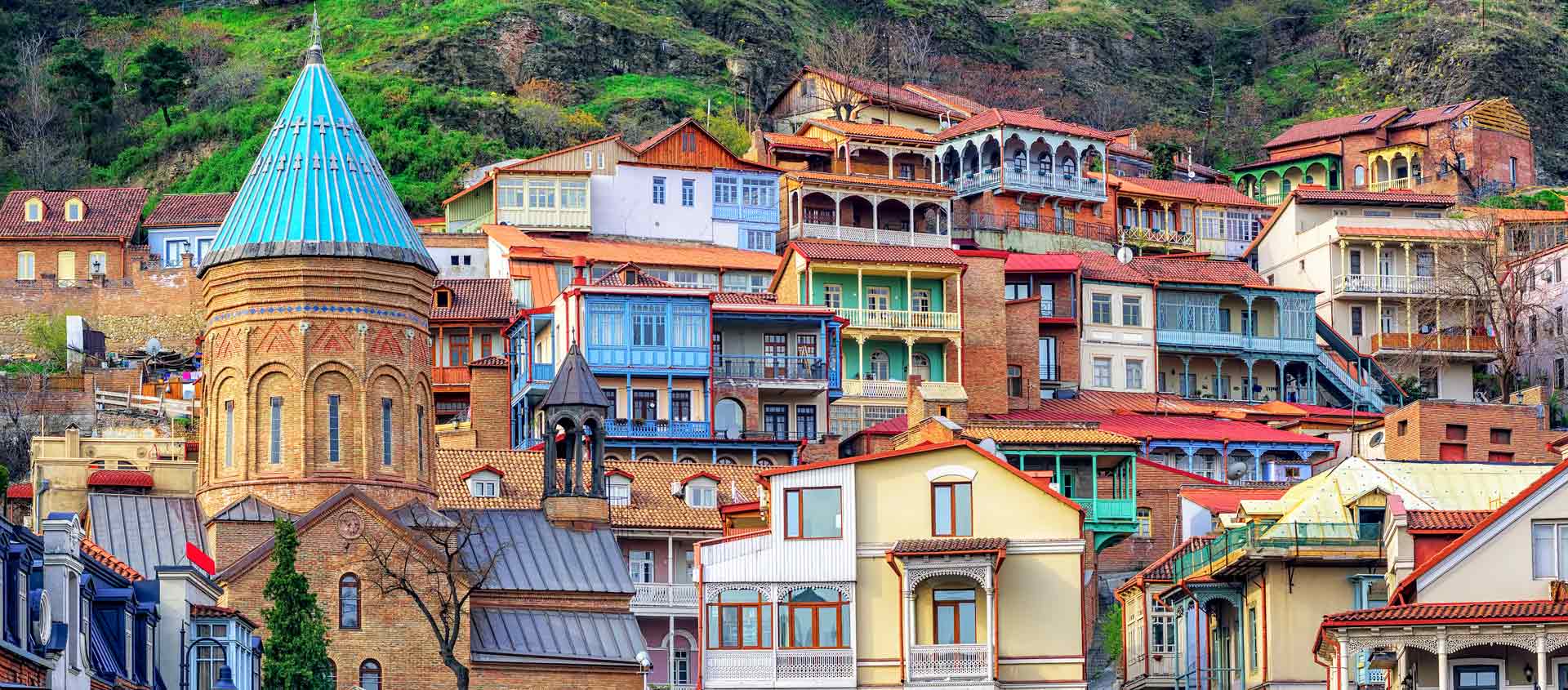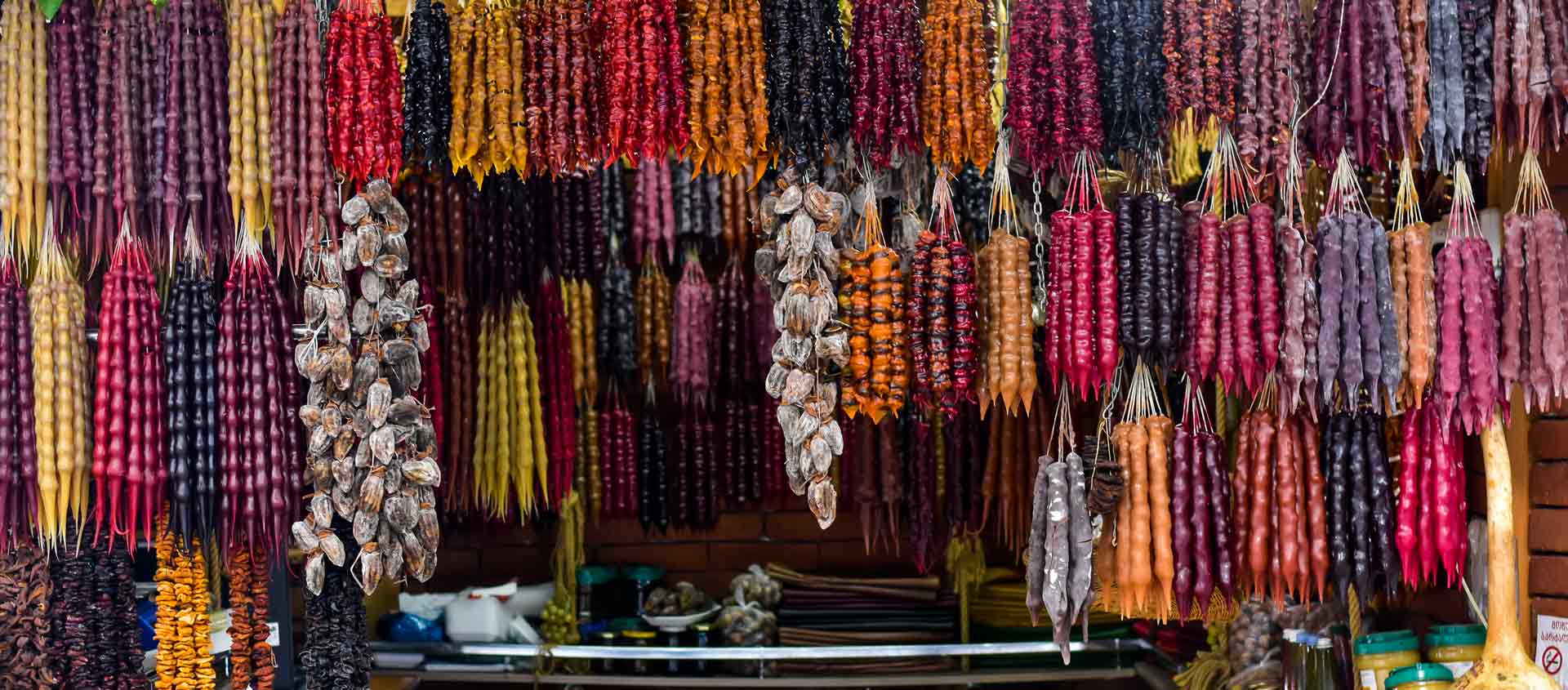Azerbaijan, Georgia & Armenia
Azerbaijan, Georgia & Armenia Tour
For centuries, Silk Road traders crisscrossed these legendary lands at the intersection of Europe and Asia, and their diverse influences remain on full display. Journey through the spectacular Caucasus Mountains, flanked by the Black and Caspian Seas, home to prehistoric rock carvings, medieval cathedrals and elaborate caravanserais, on an 17-day tour of Azerbaijan, Georgia, and Armenia. Discover natural sites teeming with rare birds—highly sought after due to their small global range—and visit jaw-dropping mountain villages virtually untouched by the modern world. Explore ancient fire worship in Azerbaijan. Tour vineyards at the birthplace of wine in Georgia, and sample three magnificent national cuisines. Visit fourth-century monasteries in Armenia. Delve into colorful history in the key cities of Baku, Tbilisi, and Yerevan. See the splendor that’s been revealed as these countries have shed their Soviet past and embraced their rich and unique cultural history.
Destinations
- Travel by Air
- Travel by Road
- Travel by Boat
- Travel by Bullet Train
- Travel by Rail
- Travel by Dog Sled
- Day 1
- Day 2
- Day 3
- Day 4
- Day 5
- Day 6
- Day 7
- Day 8
- Day 9
- Day 10
- Day 11
- Day 12
- Day 13
- Day 14
- Day 15
- Day 16
- Day 17
-
Sunday, May 5: Arrive Baku, Azerbaijan
Arrive late tonight in Azerbaijan’s capital city on the balmy Caspian Sea, the architectural love child of Paris and Dubai, with more than a dash of Soviet gravitas still to be found. Transfer to Fairmont Baku for your overnight.
-
Monday, May 6: Baku
Take the morning to acclimate from your travels. After lunch, head out on a guided walking tour of Baku. See the medieval walled city, Icheri Sheher, with its narrow alleyways, historic caravanserais and mosques. Visit the magnificent and distinctive UNESCO World Heritage sites Palace of the Shirvanshahs and Maiden Tower, dating back to the Middle Ages and earlier. See the imposing mansions of the oil barons, built in the oil boom between 1870 and 1914, and the Alley of Martyrs, perched on a hill overlooking the Bay of Baku, memorializing those who gave their lives for Azerbaijan’s independence. Enjoy a festive welcome dinner at a local restaurant. Overnight at Fairmont Baku.
-
Tuesday, May 7: Baku
This morning, head out of the city to Shirvan National Park, one of Azerbaijan’s top nature sites, home to Goitered (Persian) Gazelles, flamingoes and a host of water birds. Visit the Gobustan Historical Reserve, a UNESCO World Heritage Site best known for its perfectly preserved petroglyphs, dating back nearly 15,000 years—from the end of the Upper Paleolithic era to the Middle Ages. Visit its interactive museum for informative exhibits on the flora and fauna of Gobustan. After lunch, visit Villa Petrolea, a sprawling estate built by the Nobel Brothers’ petroleum company in 1884. Next, head to Surakhani Town on the Absheron Peninsula to see Baku Ateshgah, the Fire Temple of Baku, built in the 17th century and used at different times as a Hindu, Sikh, and Zoroastrian temple. Afterwards, if time permits, visit nearby Yanar Dag, or “Burning Mountain,” a spontaneously occurring natural gas fire whose flames blaze continuously. See the 12th-century Quadrangular Castle in Mardakan, as well as Villa Petrolea, a sprawling estate built by the Nobel Brothers’ petroleum company in 1884. Dinner and overnight at Fairmont Baku.
-
Wednesday, May 8: Baku / Sheki
After breakfast, drive west through beautiful farmland toward Sheki, once an important stop on the famed Silk Road. On the way, visit the 15th-century Diri Baba Mausoleum, built into a rock cliff. Stop in Shemakha for a tour of Djuma Mosque, the oldest and largest mosque in Azerbaijan, reconstructed in the 19th century, but dating back to the 10th century. Visit the Seven Domes Royal Cemetery. In Sheki, visit the lavish Summer Palace of the Sheki Khans, one of the most prized Azerbaijani architectural gems. Drive to the old Kish Village outside of Sheki to see a church built in the period of Caucasian Albania. Dinner and overnight at Sheki Palace Hotel.
-
Thursday, May 9: Sheki / Tsinandali, Georgia
This morning, head west to the Georgian border. At Lagodekhi, transfer to Georgian transport and choose from two activities. Hikers may join a guided walk through the Lagodekhi Protected Areas. The path passes through gorgeous hornbeam, oak, and beech forest, leading to the medieval Machi Fortress, which houses a small family church. During the walk, be on the lookout for the likes of Black Redstart, Eurasian Cuckoo, and Bird’s-nest Orchids. Alternately, head to Kvareli and dine with a local family. Try your hand at making churchkhela, a traditional dessert made with grape juice and walnuts. After lunch, see the 17th-century ruins of Gremi city. Visit a traditional Georgian wine cellar and taste an array of wines produced using the ancient tradition—a method inscribed in UNESCO’s intangible heritage list. Dinner and overnight at Tsinandali Estate Georgia Radisson Collection Hotel.
-
Friday, May 10: Tsinandali / Stepantsminda
Today, drive along the Greater Caucasus, through the jaw-dropping Gombori Pass and up the famous Georgian Military Highway. On the way, visit Ananuri Complex, once home to the Aragvi feudal dynasty. It’s a miracle the complex still stands, given all the battles it endured. The fortress bore witness to the massacre of the Aragvi clan, multiple peasant revolts, and fires. It holds two castles joined by a curtain wall once used for defense, and three churches. The complex looks out over the beautiful Zhinvali Reservoir. This afternoon, arrive in Stepantsminda, a picturesque valley town with the snowy cone of Mt. Kazbek towering over it. Take a birding walk along the Terek River, looking for Wallcreepers, Red-fronted Serins, Ring Ouzels, and more. Dinner and overnight at Rooms Hotel Kazbegi.
-
Saturday, May 11: Stepantsminda
Rise early for an optional birding excursion to search for Black Grouse, Caucasian Snowcocks, and East Caucasian Tur. After breakfast, visit the spectacularly situated Gergeti Trinity Church. An architectural feat of the 14th century, perched at 7,000 feet and surrounded by high mountains and wildflower-speckled fields, it has become a national symbol of Georgia. This is also an opportunity for some high-altitude birding—search for Mountain Chiffchaffs and Great Rosefinch. After lunch, divide into two groups to either drive through the beautiful Dariali Gorge and enjoy a hike through a narrow, steep-sided gorge to Gveleti Great Waterfall, or return to Stepantsminda for a demonstration of Georgian felt making. Dinner and overnight at Rooms Hotel Kazbegi.
-
Sunday, May 12: Stepantsminda / Tbilisi
This morning, drive to Chateau Mukhrani, the first true Georgian Royal Chateau, which unites vineyards, a winery, and history. Taste local wines produced using key elements of Georgian traditional winemaking. Enjoy lunch before continuing to Mtskheta, the ancient capital and religious center of Georgia, inhabited since before 1,000 BC. Here, visit the UNESCO World Heritage site of 6th-century Jvari Monastery. On the way to Tbilisi, stop at Lake Lisi for a short birding walk, looking for Little and Great-crested Grebes, Marsh Harriers, shrikes and wheatears. Enjoy dinner in a Tbilisi restaurant. Overnight at Hotel Tbilisi Marriott.
-
Monday, May 13: Tbilisi
You may choose to rise early this morning for a bird watching excursion to Jandari Lake, where 20,000 migratory water birds overwinter. On and near the water’s edge look for Glossy Ibis, Purple and Squacco Heron, Great Egret, Pygmy Cormorant, kingfishers and a selection of terns. In the surrounding fields, look for Booted and Short-toed Eagles, Hoopoes, bee-eaters, shrikes, Rosy Starlings and beautiful Demoiselle Cranes. Alternately, take the morning at leisure in Georgia’s vibrant capital city. Afterwards, the whole group will join up in the afternoon for a city tour. Perched on the banks of the Mtkvari River, Tbilisi is one of the world’s oldest settlements, dating back to 4,000 BC. Its history as a Silk Road hub has played a role in its ethnic and architectural diversity. A walk from the Persian-style sulfur baths into the old city reveals Georgian and Armenian churches, mosques, synagogues and the ruins of a Zoroastrian fire temple. Visit the 13th-century Metekhi Church. Take a cable car for panoramic views over the town and through the 4th-century Narikala Fortress. Head to a local restaurant for dinner. Overnight at Hotel Tbilisi Marriott.
-
Tuesday, May 14: Tbilisi / Dilijan, Armenia
Drive to the border with Armenia at Sadakhlo, change guides and vehicles, and continue to the towering 10th-century basalt fortifications of the Akhtala Monastery, famous for its stunning 13th-century frescoes, rarely found in Armenian churches. Continue south to the UNESCO World Heritage-listed Haghpat Monastery Complex, founded by Queen Khosrovanush in 976. Among the most outstanding examples of medieval Armenian architecture, the complex houses several churches, a bell tower, repository, and fortress. After lunch at a local restaurant, drive to the spa town of Dilijan, known as Armenia’s “Little Switzerland” due to the densely forested valleys and alpine meadows surrounding it. Tour the Old Town, with its pristine traditional architecture. Enjoy dinner at a local restaurant, and overnight at Best Western Plus Paradise Hotel Dilijan.
-
Wednesday, May 15: Dilijan / Jermuk
After breakfast, head to Dilijan Forest to look for Great Spotted and Middle Spotted Woodpeckers, European Nuthatches, Eurasian Tree-creepers, flycatchers, Green Warblers, Eurasian Jays, and more. Continue on to Lake Sevan, the second-largest alpine lake in the world, and “the Emerald of Armenia.” If time permits, visit the simple, and beautifully located, 8th-century Sevanavank Monastery on the lakeshore. After lunch, drive through Selim Pass and visit Selim Caravanserai, once an important trading station on the Silk Road. Continue through the impressive Arpa River Gorge to the resort town of Jermuk, watching for a selection of raptors that could include both Golden Eagle and Bearded Vulture. Enjoy dinner and overnight at Grand Resort Jermuk.
-
Thursday, May 16: Jermuk / Goris
This morning head to Jermuk Waterfall, known locally as “Mermaid’s Hair,” as the cascade is reminiscent of flowing tresses. Then, take a 4×4-vehicle excursion to Mount Murad to visit remote rock engravings at 10,500 feet, and tombs dating back to 6,000 BC. The site contains an interesting circular enclosure with two strands of stone and a stone arc attached to it, but this, along with much of Armenia’s rich archaeological heritage, has not yet been thoroughly studied. After lunch, head to Zorats Karer, vernacularly known as Karahundi, and referred to as “Armenian Stonehenge.” Karahundi consists of over two hundred stone monoliths, eighty of which have distinctive, well-polished holes bored near their upper edge. It’s believed to be an ancient observatory, as nearby rock paintings were discovered in 2001 that depict astronomic patterns. Continue to Goris for dinner and overnight at Mirhav Hotel.
-
Friday, May 17: Goris
Goris’ location is second to none, encircled by verdant mountains and thousands of jagged rocks, many of which have dwellings dating back to the Middle Ages carved into them. This morning, explore the area. Drive to nearby Old Khndzoresk, a cave village located on the steep slope of a gorge. Fully inhabited through the 18th century with more than 8,000 residents, this village carved out of rock once boasted homes, schools, cheese factories, churches, and even a bar. After lunch, ride the world’s longest air tramway, “Wings of Tatev.” Visit the 9th-century Tatev Monastery, a staggering architectural mecca built at the “edge of nothing.” Return to Goris for dinner and overnight at Mirhav Hotel.
-
Saturday, May 18: Goris / Yerevan
After breakfast, head to the exquisite Noravank Monastery, a great religious center of the 12th century, located within a deep red rock gorge, which also accommodates herds of Bezoar Ibex. After lunch, visit the Areni-1 Cave Complex, a treasure trove of Copper Age artifacts including the world’s oldest shoe and wine-making facility. Then enjoy a walk along the Armash Fishponds, an ornithological treasure trove, to look for White-headed Ducks, White-winged Terns, White-tailed Lapwings, cuckoos and many others. Head to Yerevan for dinner at a local restaurant, and overnight at Grand Hotel Yerevan.
-
Sunday, May 19: Yerevan
Depart early today to Kari Lake on the slopes of Mount Aragats, Armenia’s tallest mountain at 13,400 feet. According to ancient legend, Aragats and Mount Ararat were loving sisters who parted after a quarrel. Choose to climb to the crater rim and follow it to Urtsasar peak for spectacular views. Or, opt to enjoy some fine birding and a visit to Ambert Castle at its base. Return to Yerevan for dinner in a local restaurant. Overnight at Grand Hotel Yerevan.
-
Monday, May 20: Yerevan
Known as the Pink City thanks to the rosy volcanic tufa used to construct its neoclassical buildings, Yerevan is Armenia’s largest city. Begin your walking tour at Republic Square, and visit the Opera House, Cascade Complex and Victory Park, with its impressive Mother Armenia statue. Take a sobering tour of the Armenian Genocide Museum, with displays commemorating the 1.5 million Armenians exterminated by the Ottoman Empire. Afterwards, drive to Kotayk Province for lunch and a traditional lavash-baking presentation in a local home. Visit the 1st-century pagan temple of Garni. Higher up the Azat River Gorge, find the UNESCO-listed medieval Geghard Monastery. Return to Yerevan for a tour and tasting at its famous brandy factory. Head to a local restaurant for your farewell dinner. Overnight at Grand Hotel Yerevan.
-
Tuesday, May 21: Yerevan / Home
Transfer to the airport for your early morning international flights home.

